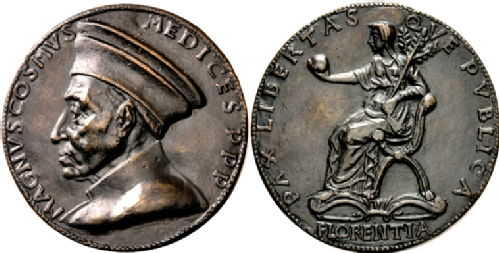All 1 entries tagged Medici
No other Warwick Blogs use the tag Medici on entries | View entries tagged Medici at Technorati | There are no images tagged Medici on this blog
January 01, 2014
Medal of Cosimo de' Medici, Pater Patriae
 |
| Medallion of Cosimo I de'Medici as Pater Patriae |
This bronze medal is the earliest example of a product created by the Florentine school. It celebrates Cosimo I de’Medici (1389-1464). He was the head of the de’Medici family, a family of bankers who were the de facto rulers of Florence during most of the Italian Renaissance. Cosimo I was granted the title Pater Patriae by the Florentine Signoria after his death on 1 August 1464. According to some scholars, the title was actually conferred on him through a decree dated to 20th August 1464, while others argue that he was granted this title through a decree dated to March 16th 1465. However, the medal was certainly not produced after 1469, the year of Piero il Gottoso’s death; the latter was the dedicatee of an Aristotelian manuscript —Florence, Biblioteca Medicea Laurenziana, Ms Plut. 84, I, c. 3— which was produced by Francesco di Antonio del Chierico on behalf of Piero di Lorenzo de’Medici. Indeed, the effigy of the medal was copied in an illumination of the manuscript by Francesco del Chierico.
The obverse of the medal presents the bust of Cosimo I in profile, facing left. He is wearing a flat beret, which was proper for persons of high rank, and a buttoned cloak. The circular legend, in Roman capital letters, reads as follows: MAGNVS COSMVS MEDICES P(RIMVS) P(ATER) P(ATRIAE).
The reverse shows a female figure, seated on a throne, which is the allegory of Florence: indeed the exergue reads FLORENTIA. The figure is inspired by Graeco-Roman coins depicting Concordia. She is wearing a peplos and is veiled, likely as a sign of mourning for Cosimo. In her left hand she holds an olive branch ending in three shoots. In the other hand, stretching forward, she grasps a globe, which might recall the Medici family emblem: a set of red balls on a gold shield. The folding seat of Florentia is placed upon a yoke on the ground. The circular legend of the reverse reads PAX LIBERTASQVE PVBLICA.
A golden exemplar of the medal is shown in a relief in gilded stucco inset into the Portrait of a Young Man with a Medal of Cosimo il Vecchio by Botticelli, now preserved in the Uffizi. The likeness of Cosimo de’ Medici depicted in the medal also inspired numerous posthumous portraits of him, including that by Jacopo Pontormo in the Uffizi.
Many different artists have been proposed for the medal’s creator: Niccolò di Forzore Spinelli, Donatello, Michelozzo, Cristoforo di Geremia, and Bertoldo di Giovanni. Nevertheless, the controversial question concerning the author’s identification basically remains a mystery. According to a fascinating interpretation, the young man depicted in the portrait by Botticelli might be the designer of the medal, Antonio Botticelli, the painter’s brother. Antonio Botticelli had indeed recast and gilded medals, working in the court of the Medici family.
The whole idea of a ʽportraitʼ on coins, as shown here, as well as the title pater patriae, was inspired by the rediscovery of Roman coins in the Renaissance, as medieval coinage did not have portraits. Ancient coins, especially the Roman imperial sestertii, were the subject of interest and intense study among Renaissance scholars from the early fifteenth century onwards. These coins were admired by humanists for their large size, their high relief, and the use of bronze, which was rarely used for medieval coinage. As a result of a process that started in the thirteenth century, various minting authorities introduced significant innovations in the appearance of the circulating coinage. Additionally, the influence of some aspects of ancient coinage resulted in the creation of a new artistic medium in the medal.
A substantial difference between Roman imperial coins and their medieval counterparts was, first of all, the profile portrait bust of a ruler on the obverse, and secondly the representation of classical deities, contemporary scenes or monuments on the reverse. Coins of the later Middle Ages did not have the reverse exergue line, often with letters beneath it, and the legends were less detailed and written in the Gothic letters derived from medieval book hands rather than the Roman capital letters used on imperial coins.
 This month’s coin was chosen by Rocco Di Dio, a third-year PhD student. His research project focusses on three Greek manuscripts produced by the Renaissance scholar Marsilio Ficino (1433-1499), who was largely responsible for the revival of Platonism in western Europe. Rocco’s main interests lie in Palaeography, Codicology, Byzantine Studies, Platonic philosophy and the Renaissance reception of Platonism.
This month’s coin was chosen by Rocco Di Dio, a third-year PhD student. His research project focusses on three Greek manuscripts produced by the Renaissance scholar Marsilio Ficino (1433-1499), who was largely responsible for the revival of Platonism in western Europe. Rocco’s main interests lie in Palaeography, Codicology, Byzantine Studies, Platonic philosophy and the Renaissance reception of Platonism.
(Image above reproduced courtesy of Dr. Busso Peus Nachfolger, Auction 400, lot 1332)
 Clare Rowan
Clare Rowan

 Please wait - comments are loading
Please wait - comments are loading

 Loading…
Loading…

